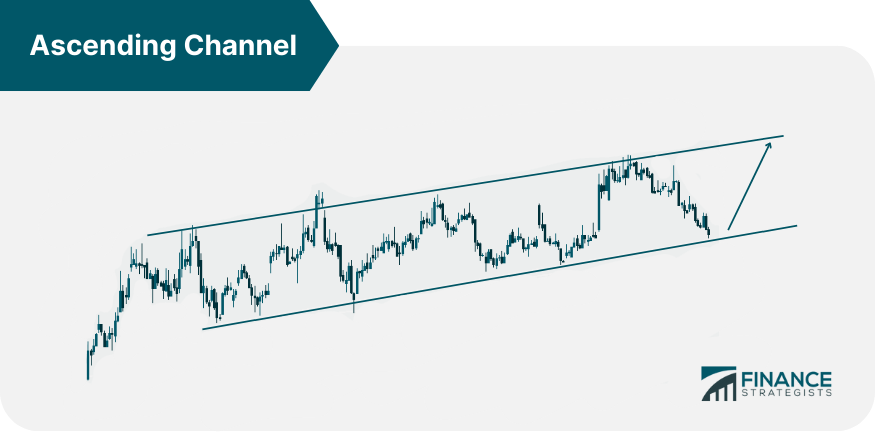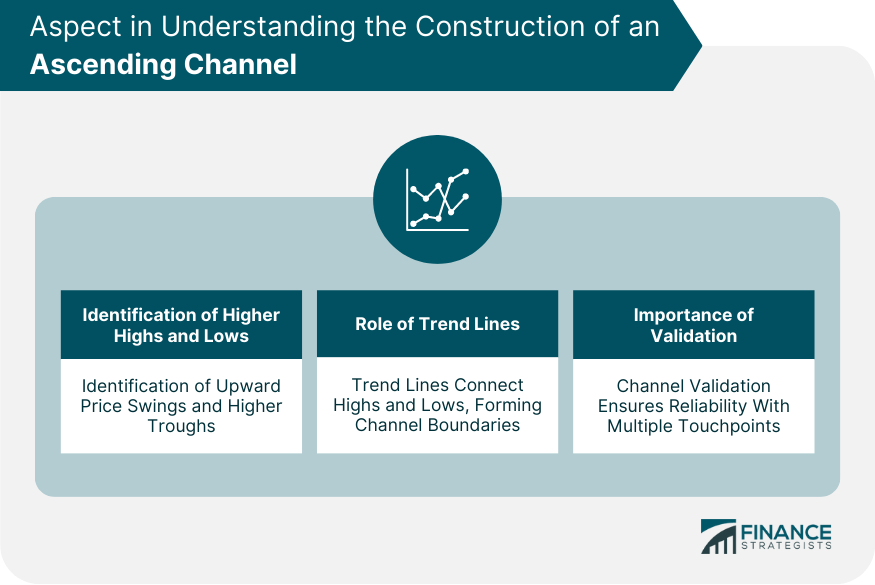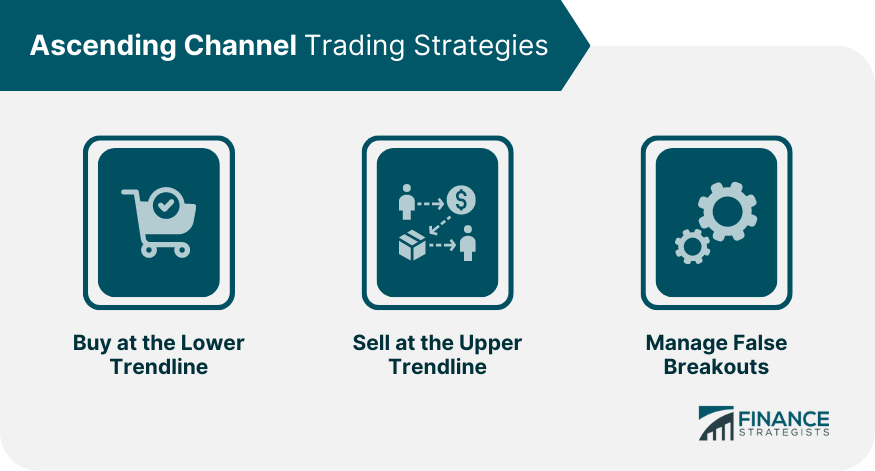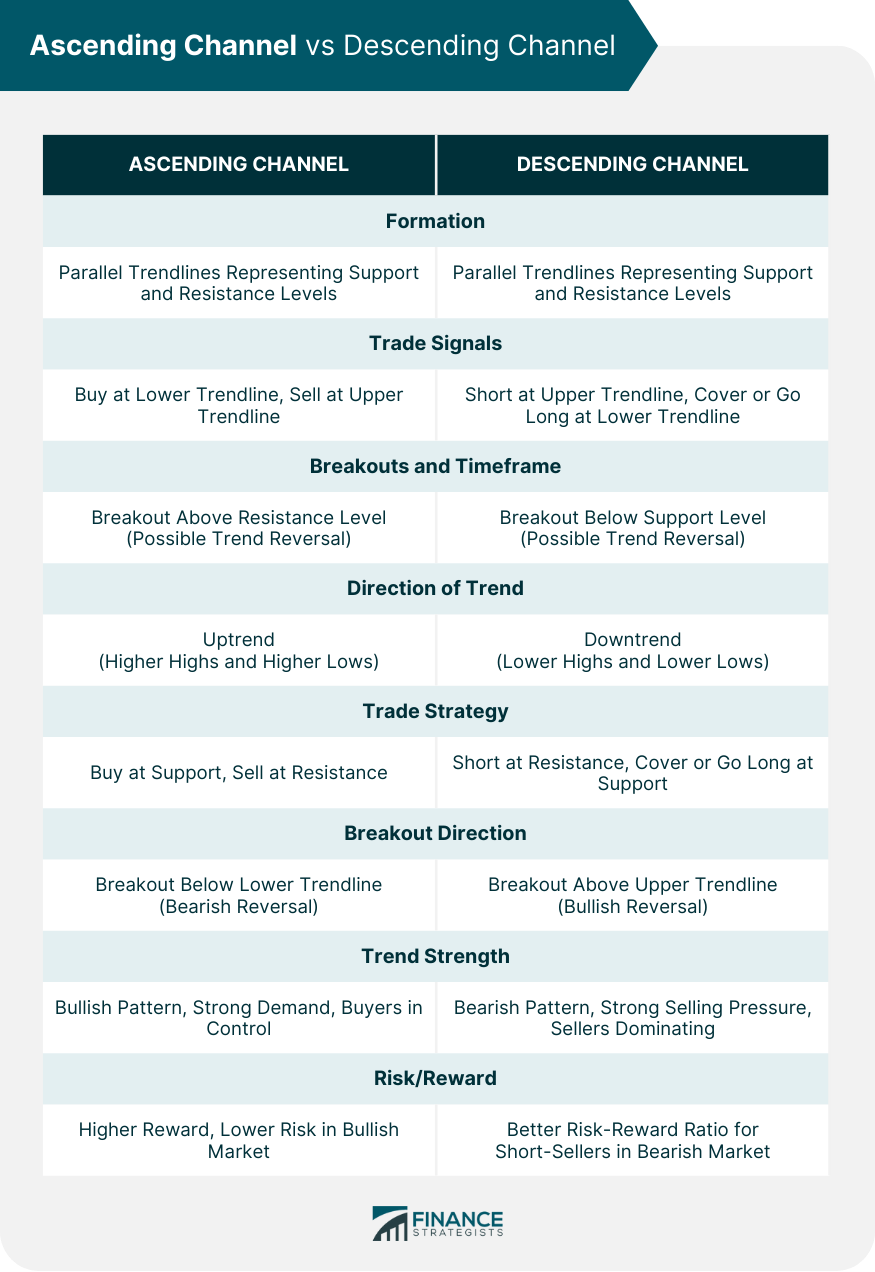The Ascending Channel is a valuable instrument in trend analysis. It refers to the price pattern created by drawing two parallel upward-sloping trend lines that act as support and resistance, marking the highs and lows of price action over time. These channels are indicative of a bullish market environment and provide crucial insights to investors. It plays a significant role in financial analysis. By highlighting the upward momentum in the price of an asset, it assists traders in identifying potential entry and exit points and setting up price targets. Moreover, it offers an overview of the general price movement, serving as a guide for traders to anticipate future price trends and make informed trading decisions. The construction of an Ascending Channel begins with the identification of higher highs and higher lows in price action. This essentially means that each subsequent peak and trough is higher than the previous one, indicating an upward trend. These points are then connected using trend lines to create the channel. Trend lines are pivotal in the formation of Ascending Channels. They are drawn to connect the higher highs (forming the upper trendline or resistance) and the higher lows (forming the lower trendline or support). This creates a channel within which the price is expected to fluctuate, reflecting a bullish sentiment in the market. Validating the channel is a crucial step in ensuring its reliability. An Ascending Channel is typically considered valid if it has at least two touchpoints on each trend line. Additionally, the more times the price touches the trendlines, the stronger the channel is considered. The Ascending Channel is a clear identifier of bullish trends in the market. It visually represents the upward momentum of an asset's price over time. As long as the price stays within the channel, the bullish trend is considered intact. Ascending Channels can also help identify potential breakout and reversal patterns. For instance, a break above the upper trendline might suggest an acceleration of the bullish trend, while a break below the lower trendline could signal a possible trend reversal. Furthermore, Ascending Channels can provide a rough estimate of potential price targets. Often, the width of the channel at the breakout point is used to project how much the price could move after breaking out of the channel. One of the basic trading strategies involves buying when the price bounces off the lower trendline of the Ascending Channel. This strategy operates under the assumption that the price will continue to rise and follow the channel pattern. Alternatively, traders might consider selling when the price touches the upper trendline, anticipating a pullback toward the lower trendline. This strategy is based on the concept that the upper trendline serves as a resistance level that the price struggles to break. False breakouts, when the price appears to break out of the channel but quickly reverses back into it, can lead to potential losses. Traders often use confirmation signals, such as waiting for the price to close outside the channel or using supplementary indicators to verify the breakout. Both are formed by drawing two parallel trendlines, which represent the support and resistance levels for the price action. Both the ascending and descending channels can provide trading signals. The upper trendline in both cases acts as a resistance level and the lower one acts as a support level. Traders look to buy at the lower trendline and sell at the upper trendline within the channel. Breakouts can occur in both cases. A breakout above the resistance level in an ascending channel or below the support level in a descending channel may indicate a possible trend reversal. Both channels can occur on any timeframe - intraday, daily, weekly, monthly, etc. An ascending channel indicates an uptrend, where the price makes higher highs and higher lows. The lower trendline is the support level, and the upper trendline is the resistance level. Conversely, a descending channel represents a downtrend, where the price makes lower highs and lower lows. The upper trendline is the resistance, and the lower trendline is the support. In an ascending channel, traders may look to buy when the price touches the lower trendline (support) and sell when it reaches the upper trendline (resistance). In a descending channel, traders may take a short position when the price touches the upper trendline (resistance) and cover their short or go long when the price approaches the lower trendline (support). In an ascending channel, a breakout below the lower trendline may indicate a potential bearish reversal. In a descending channel, a breakout above the upper trendline could signal a bullish reversal. Ascending channels can be seen as a bullish pattern, reflecting a period of strong demand for the asset, where buyers are in control. Descending channels, on the other hand, are a bearish pattern, indicating a period of strong selling pressure, where sellers are dominating. The risk and reward profiles could be different for these two channels, depending on the overall market conditions. In a bullish market, an ascending channel could potentially offer a higher reward with a lower risk, whereas in a bearish market, a descending channel might present a better risk-reward ratio for short-sellers. In relation to Ascending Channels, a throwback occurs when the price breaks above the upper trendline but then retraces back to the breakout point before continuing its upward trend. Likewise, a pullback takes place when the price breaks below the lower trendline but subsequently rebounds to the breakout point before resuming its downward movement. Ascending Channels do not operate in isolation. They can be used alongside other technical indicators like moving averages, volume indicators, and oscillators to enhance the robustness of the analysis and provide more accurate signals. One risk associated with Ascending Channel trading is the potential for false signals. False breakouts can often lead to losses if not managed carefully. Traders often use additional indicators or wait for confirmation before making a trading decision. Risk management is crucial in any form of trading, including Ascending Channel trading. Traders should always determine stop-loss levels and profit targets before entering a trade. Further, it's advisable to never risk more than a small percentage of trading capital on a single trade to protect against major losses. The Ascending Channel, a cornerstone of technical analysis, symbolizes an upward trend marked by higher highs and higher lows encompassed within parallel trend lines. Comprehending its construction is crucial, as it involves recognizing these peaks and troughs and drawing accurate trend lines to form a valid channel. Ascending Channel Trading Strategies further leverage these insights, primarily through purchasing at the lower trendline and selling at the upper trendline, thus capitalizing on the price movements within the channel. However, these strategies require careful risk management and the ability to distinguish genuine breakouts from false ones. The incorporation of such strategies, rooted in a strong understanding of the Ascending Channel, can provide traders with an advantageous edge in the dynamic financial markets.Definition of Ascending Channel

Understanding the Construction of an Ascending Channel
Identification of Higher Highs and Higher Lows
Role of Trend Lines in Constructing Channels
Importance of Validating the Channel

Role of Ascending Channel in Technical Analysis
Identification of Bullish Trends
Usage in Breakout and Reversal Patterns
Implications for Price Targets
Ascending Channel Trading Strategies
Buying at the Lower Trendline
Selling at the Upper Trendline
Dealing With False Breakouts

Ascending Channel vs Descending Channel
Similarities
Formation
Trade Signals
Breakouts and Timeframe
Differences
Direction of Trend
Trade Strategy
Breakout Direction
Comparison
Trend Strength
Risk/Reward

Advanced Concepts Related to Ascending Channel
Concept of Throwbacks and Pullbacks
Interplay With Other Technical Indicators
Risks Associated With Ascending Channel Trading
Potential for False Signals
Importance of Risk Management Strategies
Final Thoughts
Ascending Channel FAQs
Ascending Channel Trading refers to a trading strategy where traders aim to capitalize on the upward trends signified by an Ascending Channel, which is a chart pattern marked by two upward-sloping parallel lines.
Ascending Channel Trading helps predict price movements by visualizing the price's upward trend. It assists in identifying potential entry and exit points, setting price targets, and anticipating possible trend reversals.
Yes, Ascending Channel Trading can and should be used in combination with other technical indicators and strategies for more reliable results.
The primary risks include the potential for false signals, such as false breakouts, and the inherent unpredictability of market movements. Effective risk management strategies are essential to mitigate these risks.
With advancements in AI and automation, Ascending Channel Trading is likely to become more efficient. Algorithms could potentially detect channels and predict breakouts with higher accuracy, making the trading process more profitable.
True Tamplin is a published author, public speaker, CEO of UpDigital, and founder of Finance Strategists.
True is a Certified Educator in Personal Finance (CEPF®), author of The Handy Financial Ratios Guide, a member of the Society for Advancing Business Editing and Writing, contributes to his financial education site, Finance Strategists, and has spoken to various financial communities such as the CFA Institute, as well as university students like his Alma mater, Biola University, where he received a bachelor of science in business and data analytics.
To learn more about True, visit his personal website or view his author profiles on Amazon, Nasdaq and Forbes.











